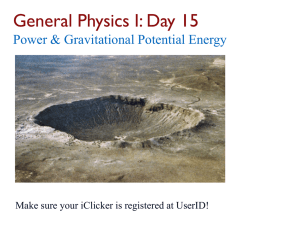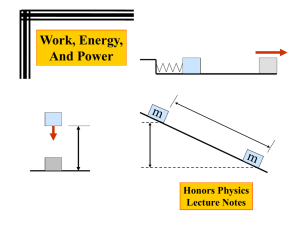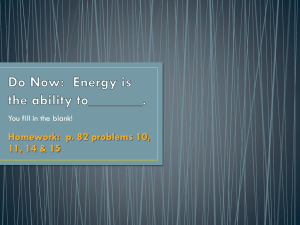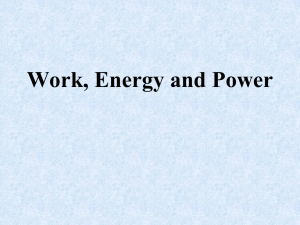Document
advertisement
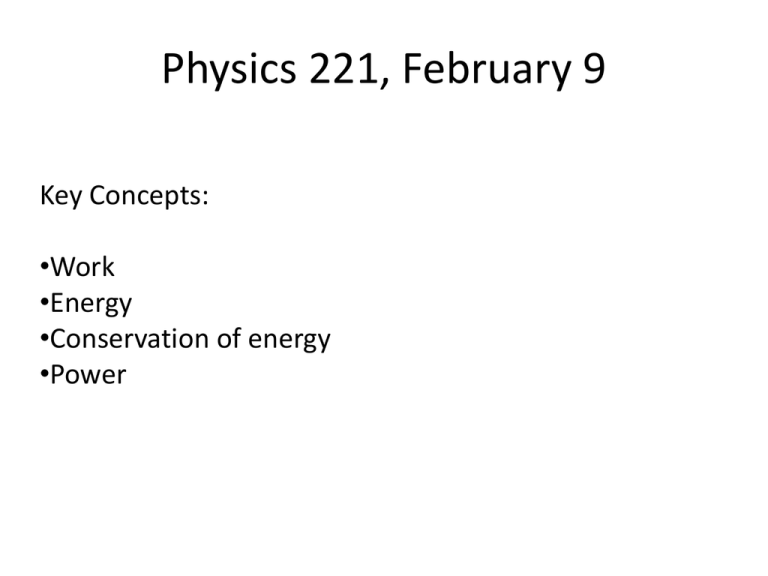
Physics 221, February 9 Key Concepts: •Work •Energy •Conservation of energy •Power Definition of Work: Work is done by a force. The work done by a force on an object is equal to the magnitude of the force, multiplied by the distance the object moves in the direction of the force. In one dimension: Work done on an object by a constant force: W = Fx (xf – xi) Work done on an object by a variable force: W = Σxixf Fx∆x, as ∆x becomes infinitesimally small. Work can be positive or negative. External work done lifting an object near the surface of Earth: Wext = mgh Work done by the gravitational force during this process: Wg = -mgh External work done stretching a spring from equilibrium: Wext = (1/2)kx2 Work done by the spring during this process: Wspring = -(1/2)kx2 Can work be done on an object without moving it? 1. Yes 2. No 30 0% 1 0% 2 A cheerleader lifts his 48 kg partner three times straight up off the ground a distance of 0.9 m before releasing her. How much work does he do? 1. 2. 3. 4. 5. 1323 J 1270 J 423 J 145 J 127 J 0% 1 0% 2 0% 0% 3 4 0% 5 30 A non-constant force is applied to a 10 kg object over a distance of 2.5 m. (See diagram.) How much work does the force do? 1. 2. 3. 4. 5. 25 J 35 J 70 J 350 J 0 0% 1 0% 2 0% 0% 3 4 0% 5 30 An ideal spring has a spring constant of 10 N/m. How much work must an external force do to compress the spring from 0.1 m to 0.13 m? 1. 2. 3. 4. 5. 0.0845 J 0.05 J 0.0345 J 0.15 J 0.65 J 0% 1 0% 2 0% 0% 3 4 0% 5 30 Extra Credit: When you fly a kite, there is a time when you must do positive work on the kite. 1. 2. 3. 4. It is the time when you let the kite out. It is the time when you pull the kite in. It is the time when you let the kite out and when you pull it in. You never must do positive work. 0% 1 0% 0% 2 3 0% 4 30 What is Energy? There is a fact, or if you wish, a law, governing all natural phenomena that are known to date. There is no known exception to this law—it is exact so far as we know. The law is called the conservation of energy. It states that there is a certain quantity, which we call energy, that does not change in the manifold of changes which nature undergoes. That is a most abstract idea, because it is a mathematical principle; it says that there is a numerical quantity which does not change when something happens. It is not a description of a mechanism, or anything concrete; it is just a strange fact that we can calculate some number, and when we finish watching nature go through her tricks and calculate the number again, it is the same. Richard Feynman Forms of energy In an given inertial reference frame: An object has kinetic energy (KE) because it moves. KE = ½ mv2 An object has potential energy (PE) because of where it is located with respect to everything that interacts with it. Potential energy is a function of position and is defined with respect to a reference position. Microscopically all energy is some form of kinetic or potential Energy. Energy conservation: ∆(KE) + ∆(PE) = 0 On a macroscopic scale we distinguish between ordered and disordered energy. The glass of water, as a whole, can have ordered kinetic energy if it moves or ordered potential energy, if, for example, it is lifted or made to hang from a spring near the surface of Earth. This type of ordered energy is called mechanical energy. The disordered kinetic and potential energy of the individual molecules is called thermal energy. Energy is always conserved. Mechanical energy is only conserved if no ordered energy is converted to thermal energy. Work results in the conversion of one form of energy into another form of energy. If the force doing the work does not convert ordered into disordered energy, we call it a conservative force. Formulas for forms of energy you should be familiar with: Translational kinetic energy: K = (1/2)mv2. Gravitational potential energy: Ug = mgh. Elastic potential energy: Us = (1/2)kx2. A young girl wishes to select one of the frictionless playground slides illustrated above to give her the greatest possible speed when she reaches the bottom of the slide. Which of the slides illustrated in the diagram should she choose? 1. 2. 3. 4. 5. A B C D It does not matter, her speed would be the same for each. 0% 1 0% 2 0% 3 0% 4 0% 5 30 Extra Credit: At time t, the kinetic energy of a particle is 30 J and the potential energy is 10 J. At some later time the kinetic energy of the particle is 40 J. Assume only conservative forces act on the particle. What is its potential energy at this later time? 1. 2. 3. 4. 5. 0 10 J 20 J 30 J 50 J 0% 1 0% 2 0% 3 0% 4 0% 5 30 Our body muscles exert forces when we lift, push, run, jump, and so forth. Are these forces conservative? 1. Yes 2. No 0% 1 0% 2 30 Jacob is dropping a ball. Let us keep track of the energy! A 750 kg automobile is traveling horizontally with speed 20.0 m/s. What is the automobile's new speed after an additional 150000 J of net work has been done on the car? 1. 2. 3. 4. 5. 28.3 m/s 40.5 m/s 80 m/s 800 m/s Its speed does not change. 0% 1 0% 2 0% 0% 3 4 0% 5 30 Power Power is a measure of how quickly this work is done, it is the rate at which work is done. P = ∆W/∆t = average power Power * time = energy transferred We can also write: P = F∆x/∆t = Fv A crane lifts a 200 kg object to a height of 10 m in 5 s. What is its power output? 1. 2. 3. 4. 5. 200 W 1960 W 3920 W 19600 W 98000 W 0% 1 0% 2 0% 0% 3 4 0% 5 30 Extra Credit: A powerful pulsed laser emits a series of brief ns (10-9 s) pulses of light, one per ms (10-3 s). If each pulse has a power of 1010 W, what is the energy per pulse? 1. 2. 3. 4. 5. 1010 J 107 J 1019 J 1013 J 10 J 0% 1 0% 2 0% 0% 3 4 0% 30 5






